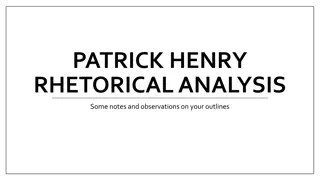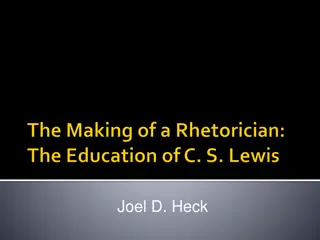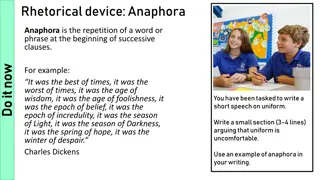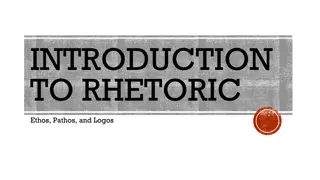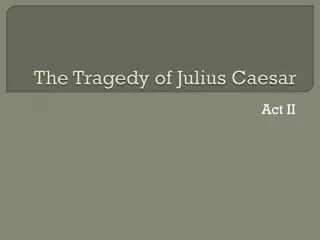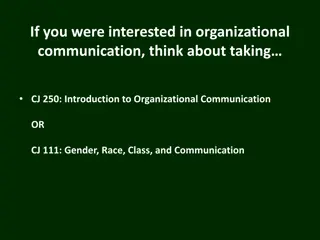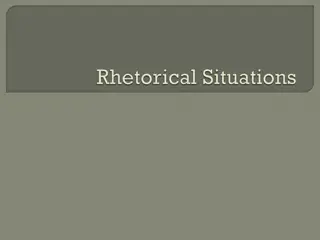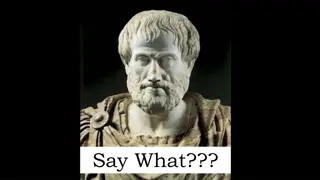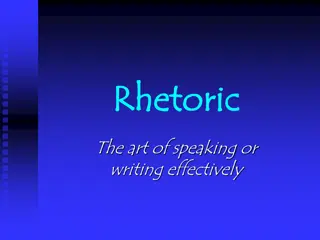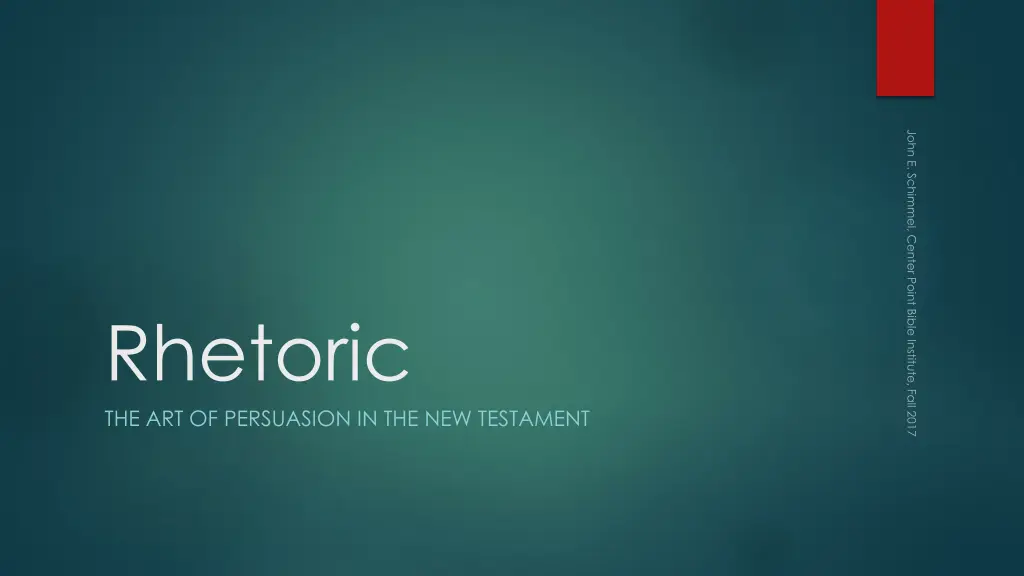
Art of Persuasion in the New Testament: A Study in Rhetoric
Explore the history of rhetoric from the Sophists to Plato and Aristotle's theory of ethos, pathos, and logos. Discover how persuasive techniques have evolved and influenced audiences throughout history.
Uploaded on | 0 Views
Download Presentation

Please find below an Image/Link to download the presentation.
The content on the website is provided AS IS for your information and personal use only. It may not be sold, licensed, or shared on other websites without obtaining consent from the author. If you encounter any issues during the download, it is possible that the publisher has removed the file from their server.
You are allowed to download the files provided on this website for personal or commercial use, subject to the condition that they are used lawfully. All files are the property of their respective owners.
The content on the website is provided AS IS for your information and personal use only. It may not be sold, licensed, or shared on other websites without obtaining consent from the author.
E N D
Presentation Transcript
Rhetoric THE ART OF PERSUASION IN THE NEW TESTAMENT
Definition Rhetoric is the art of discourse, wherein a writer or speaker strives to inform, persuade or motivate particular audiences in specific situations. As a subject of formal study and a productive civic practice, rhetoric has played a central role in the European tradition. Its best known definition comes from Aristotle, who considers it a counterpart of both logic and politics, and calls it "the faculty of observing in any given case the available means of persuasion (Wikipedia, Rhetoric ).
History Sophists (Wise Ones) The Sophists were a disparate group who travelled from city to city, teaching in public places to attract students and offer them an education. Their central focus was on logos or what we might broadly refer to as discourse, its functions and powers. They defined parts of speech, analyzed poetry, parsed close synonyms, invented argumentation strategies, and debated the nature of reality. They taught that every argument could be countered with an opposing argument, that an argument's effectiveness derived from how "likely" it appeared to the audience (its probability of seeming true), and that any probability argument could be countered with an inverted probability argument. Thus, if it seemed likely that a strong, poor man were guilty of robbing a rich, weak man, the strong poor man could argue, on the contrary, that this very likelihood (that he would be a suspect) makes it unlikely that he committed the crime, since he would most likely be apprehended for the crime. They also taught and were known for their ability to make the weaker (or worse) argument the stronger (or better).
History Plato (427 347 BC) famously outlined the differences between true and false rhetoric in a number of dialogues; particularly the Gorgias and Phaedrus dialogues wherein Plato disputes the sophistic notion that the art of persuasion (the sophists' art, which he calls "rhetoric"), can exist independent of the art of dialectic. Plato claims that since sophists appeal only to what seems probable, they are not advancing their students and audiences, but simply flattering them with what they want to hear.
Aristotle: Types of Proof Ethos Aristotle's theory of character and how the character and credibility of a speaker can influence an audience to consider him/her to be believable there being three qualities that contribute to a credible ethos: perceived intelligence, virtuous character, and goodwill Pathos The use of emotional appeals to alter the audience's judgment through metaphor, amplification, storytelling, or presenting the topic in a way that evokes strong emotions in the audience. Logos The use of reasoning, either inductive or deductive, to construct an argument. Aristotle primarily meant syllogisms (three-part deductive argument) and examples.
Syllogism Three-part deductive argument Major Premise: all humans are mortal Minor Premise: Socrates is Human Conclusion: Socrates in mortal Can be simplified as an enthymeme (incomplete syllogism) Socrates is mortal because he is human.
Argumentation Schemes Position to Know Practical Reasoning Ad Hominem Expert Opinion Waste Inconsistency Witness Testimony Sunk Costs Inconsistent Commitment Popular Opinion Ignorance Bias Popular Practice Cause to Effect Gradualism Example Correlation to Cause Slippery Slope Analogy Sign Constitutive Rule Claims Composition Evidence to Hypothesis Rules Division Consequences Exceptional Case Oppositions Alternatives Precedent Alternatives Threat Plea for Excuse Verbal Classification Fear Appeal Perception Interaction of Act and Person Danger Appeal Memory Values Need for Help Sacrifice Distress Group and Members Commitment
Slippery Slope Scheme First Step Premise: A0 is up for consideration as a proposal that seems initially like something that should be brought about. Recursive Premise: Bringing up A0 would plausibly lead (in the given circumstances, as far as we know) to A1, which would in turn plausibly lead to A2, and so forth, through the sequence A2, An. Bad Outcome Premise: An is a horrible (disastrous, bad) outcome. Conclusion: A0 should not be brought about.
Critical Questions CQ1: What intervening propositions in the sequence linking up A0 with An are actually given? CQ2: What other steps are required to fill in the sequence of events, to make it plausible? CQ3: What are the weakest links in the sequence, where specific critical questions should be asked on whether one event will really lead to another?
Aristotle: Forms of Rhetoric Forensic (judicial) Concerned with determining the truth of falseness of events that took place in the past and issues of guilt as in a courtroom. Deliberative (political) Concerned with determining whether or not particular actions should or should not be taken in the future as in making laws. Epideictic (ceremonial) Concerned with praise and blame, values, right and wrong, demonstrating and skill in the present as in a eulogy or wedding toast.
Deliberative Structure Introduction (exordium): Focus the attention of the audience and obtain its goodwill. Narration (narratio): Display the facts that constitute the background of the issue. Thesis (propositio): Define the exact thesis he is arguing (potentially dividing into multiple parts). Main body of argument (confirmatio/probatio/argumentatio): Demonstrate that one course of action is preferable to another. Digression (digressio): Designed to win the favor of hearers by giving them a break from concentration. Exhortation (exhortatio): Direct appeal to emotions. Refutation (refutatio): Counter potential arguments against the chosen course of action. Summary (peroratio): Recapitulate the arguments (enumeratio); incite the audience to hatred of the refused alternative (indignatio); strive to win the pity of the hearers (conquestio).
Scholastic Diatribe Classroom context Most identifiable feature is an imaginary interlocutor that can be addressed, or raise questions, as a conversation Other features include: The use of apostrophe (Rom 2:1, 3, 17; 9:20) Rhetorical questions (2:3-4, 21-23; 7:1; 8:31-35; 9:19-21, 30; 10:14-15; 11:34-35) Questions answered with abrupt responses like, by no means (3:2-9; 6:1-2, 15; 7:7, 13; 11:1, 11) Hyperbole (8:37-39; 9:3) Sorites, or a chain of interconnected clauses (5:3-5; 8:30; 9:14-15) Lists of vices (1:29-31), virtues (12:6-8), and hardships (8:35) Examples from the past (4:1-25; 5:12-21) Citation of written texts as authorities (e.g., 9:1 11:36)


